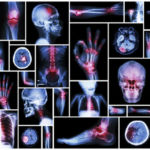This is the second article in our series covering psychological medical trauma. The first article provided an introduction to what concepts of psychological medical trauma exist and the newly-created concept of clinician-associated trauma. It also introduced a study regarding hEDS patients and clinician-associated trauma. This article will look deeper into the details of this study and what the researchers found.
[TW: patient stories about negative doctor’s visits and clinical encounters, including gaslighting, PTSD, and other trauma information]
What’s the study about?
In their article “Clinician-associated traumatization from difficult medical encounters: Results from a qualitative interview study on the Ehlers-Danlos Syndromes,” Colin M.E. Halverson, Heather L. Penwell, and Clair A. Francomano interviewed 26 adult patients with hypermobile Ehlers-Danlos syndrome (hEDS). While some patients were diagnosed with post-traumatic stress disorder (PTSD) from some of their medical experiences, other traumatic experiences did not quite fit with a PTSD diagnosis. The researchers coined a new term for these experiences: clinician-associated trauma, defined as “…a challenging ‘diagnostic odyssey,’ characterized by repeated negative confrontations with clinicians, persistent and troubling uncertainty about their health status, and a pervasive sense of anxiety and depression, rather than (solely) an unexpected and discrete brush with mortality” (Halverson et al., 2023). This new definition allows for a more precise diagnosis and validates the reality and trauma many patients with chronic, complex, and invisible illnesses experience.
What has the study found out?
Interviews were conducted over the phone and used a guide created for previous research on hEDS patients (Halverson et al., 2021). After the recorded interviews were transcribed, the researchers analyzed their data for themes and trends. They found that, in some cases, it’s not just being in the hospital, going through a life-altering procedure, or the disease itself that caused the medical trauma. “Instead, we have found that compounding negative interactional dynamics with healthcare providers result in what we call clinician-associated traumatization, which parallels the symptoms of more traditional conceptualizations of PTSD and medical trauma” (Halverson et al., 2023)
They found four themes (not diagnostic criteria) in their interviews that help define what CAT is and how it affects the patient: “1) the ubiquity of difficult clinical encounters, 2) the effect of these encounters on the patient–provider relationship, 3) their effect on participants’ trust in the healthcare system as well as in themselves, and 4) resulting negative health outcomes” (Halverson et al., 2023). These are not diagnostic criteria; rather, they are descriptors of events and processes that may lead to CAT.
How does clinician-associated trauma develop?
The universality of negative encounters with providers laid the groundwork for the rest of CAT to build on. Patients reported things like providers not listening to them and not believing them. Providers were dismissive of concerns, sometimes with the attitude that a patient’s experience or research was unimportant. This is especially true for complaints about pain or fatigue. “One individual [in the study] said, ‘They don’t take you seriously, or they think you’re overbearing or just paranoid,'” (253; patients were assigned a number during the study to assure anonymity). Others described arrogance and disrespect from some providers despite a lack of knowledge surrounding hEDS. They believed that providers who were frustrated with the incurability and lack of treatment for EDS allowed those feelings to come out when meeting with patients. Punitive actions could be taken as well:
After several hearing tests, she [the patient’s mother] recalls:
“The doctor strolls in, pompous, with five med students. He sits down in his chair and says, ‘She’s faking it.’ I’m like, ‘Excuse me?’ He’s like, ‘She’s completely faking it.’ Now [my daughter’s] crying in this chair with these five med students all looking at her, proclaiming based on her age and her sex – because she was female and at the time, she was like 13 or 14 – that it was typical for them to fake it. I looked at him, and I’m like, ‘We’ve been dealing with this for over a year. She wears hearing aids; she’s had multiple tests. You don’t get it. We’ve had hearing tests at three different places, and they all come in all the same.’ He was just adamant. […] ‘She’s faking it, and she just needs to stop.’ […] I never went back to him. He then also called the organization associated with the School for the Deaf that advocates for kids with hearing loss. […] He went and told them that she was faking it. I don’t even know what would possess someone to be that vindictive and evil!” (256)
Not all doctors are like this, of course. However, it’s situations like the one above–and many more similar encounters–that, together, cause clinician-associated trauma. If the patient doesn’t have the option to switch doctors, they may need to find ways to put up with the behavior of the clinician, especially if the clinician is an integral part of their treatment plan.
CAT leads to poor provider-patient relationship
When there’s what looks like a lack of trust on both sides, an unhealthy patient-provider relationship can form. Patients in the study admitted that their reticence and detached attitude could have exacerbated the stress already present in the relationship. However, they felt the providers’ actions made it difficult to trust them with deep, vulnerable emotions. “Many [patients] described consciously trying to moderate their emotions…: ‘If we were being ourselves or being more authentic, we would be crying […] and yelling,’ one participant stated (207). In order to curb the difficulty of her clinic visits, however, this woman explained that she refrained from openly expressing to her clinicians the extent of her discomfort and anxiety.”
One of the most troublesome parts of a poor provider-patient relationship is abandonment. When providers aren’t sure what to do with a patient, they often refer them to another colleague who may be able to help. However, a lot of times, this feels like the provider is abandoning them–and 73% of the patients in the study agree that they felt abandoned. One patient described it: “When she [the patient] was told by a clinician whom she had seen for a while and had come to trust, ‘I really don’t know what to do with you. I’m at a loss,’ she wanted to cry out: ‘I understand that you don’t know what to do, but we can’t just leave me here like this!'” (116). Providers often feel like they have to “know it all” and when they don’t, it can be a difficult realization, which they may take out on the patient whom they see as causing the frustration.
In addition to a messy ball of feelings regarding provider abandonment, the patient is left with an unenviable choice: trying to navigate the Byzantine maze that is the American healthcare system. They need to find new doctors or get referrals and go through the process of learning to trust a provider. They need to organize transportation and assistance, request records and fill out various types of paperwork, manage insurance issues, including appeals and prior authorization, without a trusted person who understands how the system works. “‘I’ve been on the phone with insurance for about half my life,’ one woman told us (210)”. What started as a journey for answers about new symptoms has now turned into an emotionally fraught search for healthcare.
A common cause for trauma: medical gaslighting
Another common interaction that can cause CAT is physician gaslighting. One study participant was told by her doctor that her symptoms were “all in her head.” “‘How would that not make someone doubt themselves when a medical doctor tells me that he thinks it’s all in my head? […] And I’m like, “What if it is? What if I’m just making all this up and I’m just crazy?”‘” (355). “Another participant explained, ‘You’re crying out and asking- begging for help, and then not being believed. And it’s not one doctor; it was many doctors, and then that’s traumatizing in itself’ (155)”. This uncertainty only adds fuel to the fire–the patient has now been traumatized by the provider, the system, and now by their own self-doubt. No wonder many people decide to find treatments outside of the standardized healthcare system.
CAT causes irreversible harm.
The last theme the research found was that these actions then caused negative effects on the patient–some of which could not be reversed. Eighty-one percent of the patients interviewed said they had a negative consequence due to inappropriate care given in the clinic (Halverson et al., 2023). If a provider is too arrogant to listen to their patient or thinks they know better than the patient, the results could be disastrous, like the woman who received an antibiotic for a sinus infection that made her connective tissue laxer. She woke up in the middle of the night gasping for breath (Halverson et al., 2023). Wounds from adhesives on the skin, spinal taps that don’t clot, underestimating the fragility of the skin or a joint and causing more problems, x-rays that “look fine,” physical therapists who don’t pay attention to limitations and are too aggressive, test results that are negative. No follow-up, no next steps, no digging deeper, no apologies. Just a shrug and being told, “I guess it’s just your Ehlers-Danlos.” The patient feels like a cog in the medical machinery. The current practice of medicine is so rigid and filled with protocols that many EDS patients are harmed simply because someone didn’t listen to the patient about a precaution or thought they knew more about EDS than they really did.
While these are the four main themes covered in the hEDS survey for this study, there are other insidious ways patients are made to feel unheard, unvalued, and uncared for. In some cases, a provider may not realize what they’re doing is creating such a negative effect on their patient. Only 15% of the patients said that clinicians recognize their weaknesses always or most of the time. Eleven percent of patients said clinicians were receptive to new ideas (Halverson et al.). This leads to simple answers to help ease or stop clinician-associated trauma.
What can we do to stop CAT?
- Education: The first is education. Patients theorized that part of the frustration came from not knowing enough about a rare condition in order to competently treat the patient: “an important source of strife in their clinic visits was clinicians’ lack of humility in encountering a relatively rare disorder about which they often knew little” (Halverson et al., 2023). In these cases, clinicians can turn to the little knowledge they have or make assumptions about what needs to be done rather than seeking out an expert to guide them. Patients may bring in articles or information, but often, clinicians don’t have time to read it. It becomes a struggle between the doctor, whom society has imbued with power and wisdom, and the patient who has experience living with the condition, but the patient is always on the losing end in terms of perceived power and wisdom.
- Awareness: The second is awareness: Knowing the differences between people with EDS and those without. Having more knowledge about how EDS relates to their specialty. Removing these types of sentences from providers’ mouths: “I think I heard of that in medical school. It’s something to do with joints, yeah?” Doctors will often say that they’ve had another patient with EDS and feel like they know what to do, but, as we know, no two zebras have the same stripes. Nurses and nursing assistants need to learn about EDS; lab technicians, imaging technicians, physical, occupational, behavioral health, and speech-language therapists–and probably some people I’m missing–need to learn about EDS in order to treat us appropriately and keep us safe.
The key is awareness and education–either formally in med school and continuing education or informally through colleagues, advisory councils, and the patients themselves. I remember being an 8-year-old informing an ER doctor about EDS and how he needed to put stitches in deeper than usual. Thank goodness he listened. While patients shouldn’t have to be the ones to educate doctors, our collective experiences–our stories, our scars, our memories–will leave much more of a lasting impression than a 2-hour video about connective tissue.
If you are struggling with the effects of PTSD, depression, trauma, or other behavioral health concerns, please call 988 in the United States or reach out to your local emergency or urgent care department.
Kate Schultz
September 2023



THANKYOU so much for this paper.
I live in Devon, UK and this has been my exact experience, especially with GPS but also secondary care.
I’m 51 and only partially ‘diagnosed’ 2 years ago.
I found this heartening and supportive.
It gives me strength to continue to push for awareness and education.